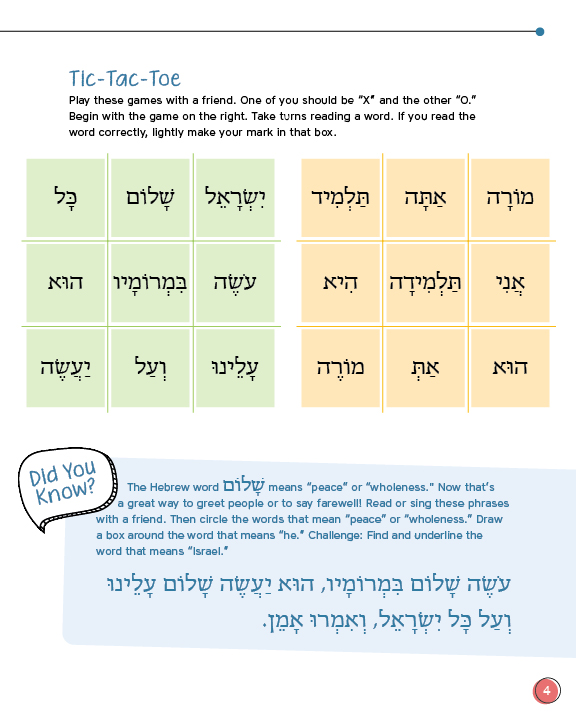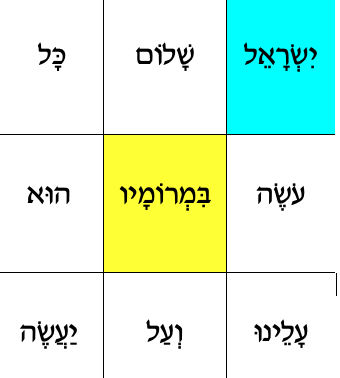After Decoding, Then What?
The key to successfully learning a second language is to have a meaningful way to use new skills, according to numerous studies by educators and linguists.
"The central issue in Hebrew reading instruction is what one does with decoding after it has been taught," says Dina Maiben, a Hebrew language expert and director of the Hebrew program at Gratz College.
"When students have texts to read that provide a balance between ease and challenge, are meaningful to them, and that build on what they have learned previously, that provides context as they progress. They become stronger Hebrew learners."
Seeing an absence of such meaningful transitional texts, Maiben created Shalom, Reader to help emerging readers students gain confidence as they read simple stories, engage in short dialogues, grow their vocabulary, and gain competence in recognizing sight words. The activities are built on simple Jewish cultural and traditional vocabulary that both repeats from chapter to chapter and grows in complexity.
Students meet a family and its pets, and are introduced to Hebrew through scenarios that they have personally experienced and that are very familiar to them, such as holiday celebrations, school, family, pets, time, and the weather. Much of the vocabulary overlaps with the Bible and siddur, making Shalom, Reader an excellent bridge between a Hebrew primer and more complex texts from a reading or prayer learning program.
Use it at the beginning of a new school year to help review basic reading skills and introduce new readers to larger texts. It's also useful at the end of the year to allow new readers the opportunity to immediately apply their new Hebrew reading skills to interesting texts.
A downloadable teachers' guide, also written by Dina Maiben, provides specific ideas for enriching the activities, and also includes strategies for teaching the material in remote learning environments.
For example, each chapter of Shalom, Reader has games to help students demonstrate their Hebrew vocabulary comprehension, such as Tic-Tac-Toe, Connect the Dots, and Four-in-a-Row.

Here are some ways to expand on Tic-Tac-Toe:
Charades: Use the Tic-Tac-Toe boards on the right side of the page. Divide the group into two teams. Have a volunteer from one team act out a word and have the others guess its meaning, either by typing in chat, raising a hand if muted, or calling it out.
Pictionary: Use the same Tic-Tac-Toe game boards, but play them Pictionary-style. Have members of each team take turns drawing a word on a blank sheet of paper and holding it up so the whole class can see. The other team has to guess the Hebrew word that it represents.
 In a remote learning environment: Create the Tic-Tac-Toe boards using either the Zoom whiteboard, a Word document, or a PowerPoint slide. Share your screen and use the annotate feature to mark the board with X’s and O’s. Call on two volunteers to play together. Repeat with different pairs.
In a remote learning environment: Create the Tic-Tac-Toe boards using either the Zoom whiteboard, a Word document, or a PowerPoint slide. Share your screen and use the annotate feature to mark the board with X’s and O’s. Call on two volunteers to play together. Repeat with different pairs.
If you’re using a Word document, you can use highlighter colors to fill in the squares. If you don’t want to pair off the students, try grouping them into two teams and having team members take turns choosing which words to read to claim the X or O for their team.
Here are some other fun ways to engage students as they become stronger readers:
- When teaching new vocabulary, have students go on a scavenger hunt in their homes and retrieve a person, animal, or item on the list. For example, they might bring their אִמָא (mother), אַבָּא (father), כֶּלֶב (dog), or חָתוּל (cat). Encourage students to be creative. For example, what will they bring to show לַיְלָה (night)? How about קַר (cold)? Have fun learning the Hebrew words for objects and people.
- Hold short competitions. For example, when completing page 7, “Did You Know? (Shalom Aleichem),” hold a word scavenger hunt. Ask: How many times can you find the word “shalom” or a variation? (7) Which phrases repeat four times? (mal’achei elyon; mimelech malchai ham’lachim; hakadosh baruch hu). And so on.
- For longer reading passages, have students act out the dialogues using props. They can record themselves on a phone (or if at home, have parent record the students), and share with the group.
Listen to Maiben explain more here:
Keep up with the latest information by subscribing to our newsletter and connect with us on social media!



